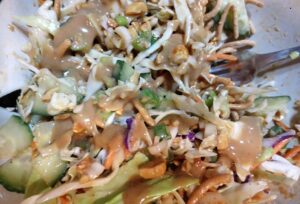 Folks, I have to tell you that this salad, made from items I had on hand and in some cases was trying to use up, is so seriously delicious that I’ve eaten it for my past three lunches straight. Today I used up the last of the dressing and thus the run has come to an end at least for now, but I plan to keep it in rotation for the future. It has (mostly) healthful ingredients and is a true one-dish meal, with lots of vegetables and good protein from peanuts. If you care about such things, it’s also vegetarian. In fact, it’s actually vegan except for the dressing. Here’s what’s in it:
Folks, I have to tell you that this salad, made from items I had on hand and in some cases was trying to use up, is so seriously delicious that I’ve eaten it for my past three lunches straight. Today I used up the last of the dressing and thus the run has come to an end at least for now, but I plan to keep it in rotation for the future. It has (mostly) healthful ingredients and is a true one-dish meal, with lots of vegetables and good protein from peanuts. If you care about such things, it’s also vegetarian. In fact, it’s actually vegan except for the dressing. Here’s what’s in it:
Food
What I Had for Lunch Today–Oct. 15, 2018
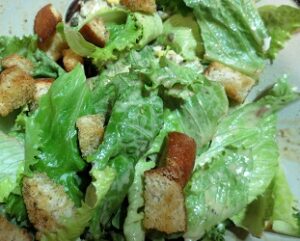 A good example of strong, sharp flavors, a lovely main-dish salad made from items I had on hand. Yes, I work from home and so could take the time to assemble this on the spot, but it could easily be adapted to taking to work: all the non-lettuce, non-crouton items mixed with the dressing, with the lettuce in one baggie and the croutons in another, all tucked inside a lidded plastic bowl that could wait inside the fridge until lunchtime and then be mixed together. This is sort of halfway between a Greek salad and a salade Niçoise. I was watching a Greek cooking show last night and realized that I could put something very similar together:
A good example of strong, sharp flavors, a lovely main-dish salad made from items I had on hand. Yes, I work from home and so could take the time to assemble this on the spot, but it could easily be adapted to taking to work: all the non-lettuce, non-crouton items mixed with the dressing, with the lettuce in one baggie and the croutons in another, all tucked inside a lidded plastic bowl that could wait inside the fridge until lunchtime and then be mixed together. This is sort of halfway between a Greek salad and a salade Niçoise. I was watching a Greek cooking show last night and realized that I could put something very similar together:
What I Had for Lunch Today, Oct. 4, 2018
 The remainder of a small head of Napa cabbage, washed and chopped
The remainder of a small head of Napa cabbage, washed and chopped
Part of a red pepper, sliced
A few shreds of red onion
Chopped peanuts
Peanut/lime dressing (scroll down on this website page to get to the dressing recipe)
Some leftover baked salmon from the night before
Lots of vegetables and protein from the peanuts and salmon
Filling and delicious!
What I Had for Lunch Yesterday
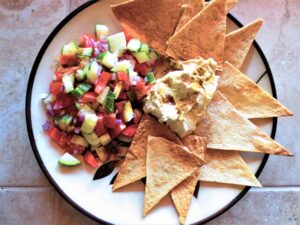 I said in a recent post that I was planning to scale back on my regular what’s-going-on-with-my-life posts and invest my time in projects that I hope will actually make a difference to my readers. One such is a set of videos on various topics concerning healthy eating. I also said that I might start some once-in-awhile posts about “what I ate today.” This is the first of those. They won’t be on any kind of regular schedule; they’ll just show up when I think a specific meal is particularly good and easy to make. (I remembered as I was writing this that I did include a picture and recipe for a lunchtime salad several years ago in connection with a memoir by the chef Nora Pouillon. Scroll down to the bottom of that post for that material.)
I said in a recent post that I was planning to scale back on my regular what’s-going-on-with-my-life posts and invest my time in projects that I hope will actually make a difference to my readers. One such is a set of videos on various topics concerning healthy eating. I also said that I might start some once-in-awhile posts about “what I ate today.” This is the first of those. They won’t be on any kind of regular schedule; they’ll just show up when I think a specific meal is particularly good and easy to make. (I remembered as I was writing this that I did include a picture and recipe for a lunchtime salad several years ago in connection with a memoir by the chef Nora Pouillon. Scroll down to the bottom of that post for that material.)
The Four Tendencies and Food–What I Talked About this Weekend at Camp
 I just had a wonderful weekend at Camp Elim, a Christian camp near Colorado Springs, where I was privileged to speak in a couple of workshops. My two topics were “What’s Your Tendency?”, an examination of Gretchen Rubin’s theory about the four ways that people respond to expectations, and “How Food Fads and Myths Can Harm You,” in which I took on some of the current ideas floating around in the eating theories world, with a few side trips into my views on alternative medicine. I may get myself into trouble with that second one! My actual group for that session was small as I was competing with a very popular one on marriage, and they all seemed very receptive to my ideas. I gave everyone who attended the sessions the opportunity to sign up for a resources page, so I decided to just turn that material into a post for all my readers to access. Here ’tis:
I just had a wonderful weekend at Camp Elim, a Christian camp near Colorado Springs, where I was privileged to speak in a couple of workshops. My two topics were “What’s Your Tendency?”, an examination of Gretchen Rubin’s theory about the four ways that people respond to expectations, and “How Food Fads and Myths Can Harm You,” in which I took on some of the current ideas floating around in the eating theories world, with a few side trips into my views on alternative medicine. I may get myself into trouble with that second one! My actual group for that session was small as I was competing with a very popular one on marriage, and they all seemed very receptive to my ideas. I gave everyone who attended the sessions the opportunity to sign up for a resources page, so I decided to just turn that material into a post for all my readers to access. Here ’tis:
Two More Books by the French Woman
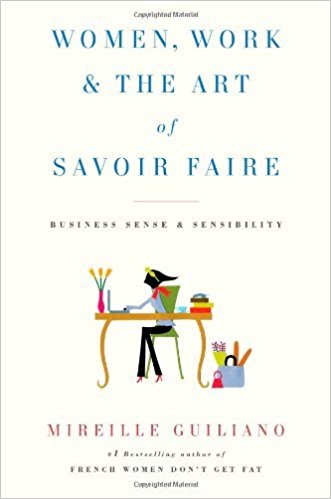
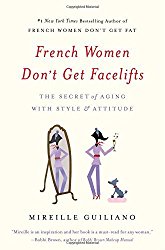
I have posted about Mireille Giuliano before, notably in reviewing her first book, French Women Don’t Get Fat. I truly love that book and re-read it periodically. To me, it’s a sound, common-sense set of principles for getting and staying slim no matter what your nationality, and I ignore the ideas that are just kind of silly. Sorry, Mireille, but very few people who live in America visit France often enough to buy their prunes there. (Of course, that’s assuming that you buy them at all . . . ) And we don’t go mushroom hunting much around here. Nor do we have blueberry bushes in the back yard to supply us with those little nutritional powerhouses. Nor do we divide our time between New York City and Provence, where there are excellent farmers’ markets year-round. (I always wonder whether or not Mireille ever goes into a regular supermarket. Probably not!) I ran into an interesting article in the UK newspaper The Guardian (but now I can’t find it) in which some Frenchwomen were interviewed about how they view their weight, and they said that Mireille’s book was a big, fat (sorry) pain in the neck because it perpetrated the myth of always-thin French women. But, and this is a very important but, those interviewees weren’t really following the FWDGF principles. Instead, they were making a practice of overindulging at restaurants, because it’s supposedly frowned upon not to eat a lot when you’re out on the town, and then starving themselves the rest of the time. Not, not, not what Mireille says to do! She would say, in her charming French accent, “Who cares what’s considered cool or not cool? You eat the way you want to, and if people don’t like it, tant pis!” (Or, as my mother used to say, “If they don’t like it, they can lump it!”) So there it is.
Establishing Healthy Eating Patterns, Pt. 1
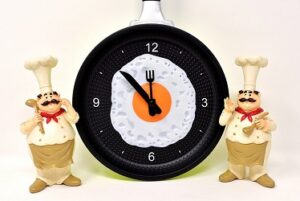 I’ve been saying for some time now that one key to healthy eating patterns is the following:
I’ve been saying for some time now that one key to healthy eating patterns is the following:
Don’t eat in the evening.
Sounds pretty simple, but there are actually quite a few moving parts involved in this brief statement, most of them running counter to the way we eat in our modern American culture. Here’s the way it can go for a
Living Up to Your “Best Self”
 Every once in a while I get an image of myself as I’d like to be: admirably self-controlled, unruffled, good-humored, respectful of others and therefore eliciting respect for herself, setting high standards for myself but being tolerant of others . . . the list goes on. It’s a picture of my so-called “best self.” That person doesn’t actually exist, unfortunately, but I find that picturing her is helpful. Last night, for example, we were at a restaurant celebrating a family birthday and I had ordered chili rellenos. Very, very good. But there were two of them, and I knew after finishing one that I didn’t need any more. I could save the rest for today. But that second one, with its crispy crust (always get the crispy rellenos! it’s a rule of life) was very tempting. I looked at it; it looked at me. And I thought, ‘My ideal self wouldn’t eat it. She’d stick to what she decided to do.’ So, while I did cut off one corner, the rest came home with me and is sitting in the fridge even now, waiting to be consumed for lunch.
Every once in a while I get an image of myself as I’d like to be: admirably self-controlled, unruffled, good-humored, respectful of others and therefore eliciting respect for herself, setting high standards for myself but being tolerant of others . . . the list goes on. It’s a picture of my so-called “best self.” That person doesn’t actually exist, unfortunately, but I find that picturing her is helpful. Last night, for example, we were at a restaurant celebrating a family birthday and I had ordered chili rellenos. Very, very good. But there were two of them, and I knew after finishing one that I didn’t need any more. I could save the rest for today. But that second one, with its crispy crust (always get the crispy rellenos! it’s a rule of life) was very tempting. I looked at it; it looked at me. And I thought, ‘My ideal self wouldn’t eat it. She’d stick to what she decided to do.’ So, while I did cut off one corner, the rest came home with me and is sitting in the fridge even now, waiting to be consumed for lunch.
Are You Guilty of Being an “Evil Donut Bringer”?
 Well, it’s getting to be somewhat of a tradition that on Wednesday I write about something that piqued my interest on the Gretchen Rubin/Liz Craft podcast, “Happier.” Today the two sisters were doing an anniversary special and revisiting some popular ideas from the past year. One of those was that of the “evil donut bringer,” that person in the office who brings in treats that tempt people who shouldn’t eat them. Liz is a Type 1 diabetic, so it’s especially important that she strictly limit sweets. But all of us have had the experience of repeatedly walking past a plate of something we know we shouldn’t eat, resisting and resisting, until finally, on the tenth pass, we reach out and grab that cupcake. We do our best to ignore that bowl of candy on a co-worker’s desk but (especially if it’s mini Reese’s peanut-butter cups), again, it’s all too easy to finally give in.
Well, it’s getting to be somewhat of a tradition that on Wednesday I write about something that piqued my interest on the Gretchen Rubin/Liz Craft podcast, “Happier.” Today the two sisters were doing an anniversary special and revisiting some popular ideas from the past year. One of those was that of the “evil donut bringer,” that person in the office who brings in treats that tempt people who shouldn’t eat them. Liz is a Type 1 diabetic, so it’s especially important that she strictly limit sweets. But all of us have had the experience of repeatedly walking past a plate of something we know we shouldn’t eat, resisting and resisting, until finally, on the tenth pass, we reach out and grab that cupcake. We do our best to ignore that bowl of candy on a co-worker’s desk but (especially if it’s mini Reese’s peanut-butter cups), again, it’s all too easy to finally give in.
Yet Another Anti-Sugar Rant
 Hope I’m not sounding like a broken record here, but I wanted to share some recent experiences with sugar intake that might save some of you from needlessly depriving yourselves of grain products. Many if not most people who think that going gluten-free is going to make them healthier are buying into a false premise. This is not to say, and I want to emphasize this point, that there isn’t real gluten intolerance, with the most extreme of course being full-blown celiac disease. But most of us need to cut out sugar, not gluten.
Hope I’m not sounding like a broken record here, but I wanted to share some recent experiences with sugar intake that might save some of you from needlessly depriving yourselves of grain products. Many if not most people who think that going gluten-free is going to make them healthier are buying into a false premise. This is not to say, and I want to emphasize this point, that there isn’t real gluten intolerance, with the most extreme of course being full-blown celiac disease. But most of us need to cut out sugar, not gluten.